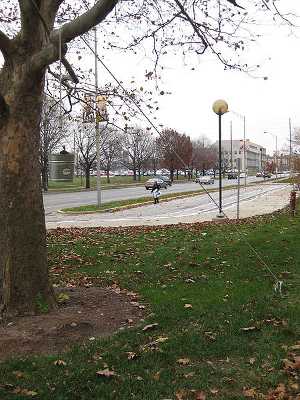Untitled (Bucket of Rocks)
 | |
| Artist | Amber Lewis |
|---|---|
| Year | 2009 |
| Type | Mixed Media |
| Dimensions | 270 cm × 43 cm × 43 cm (9 ft × 1.4 ft × 1.4 ft) |
| Location | Indiana University-Purdue University Indianapolis, Indianapolis, Indiana, United States |
'Untitled', a public sculpture by Amber Lewis, is located on the Indiana University-Purdue University Indianapolis campus, which is near downtown Indianapolis, Indiana. This mixed media sculpture consists of a metal bucket filled with rocks which is hung from a rope. This sculpture is hung from a tree which is located in front of the Herron School of Art and Design. It was made in Spring of 2009 as an assignment for a studio art class at the Herron School of Art and Design. Its dimensions are 9' x 1.4' x 1.4'.
Information
This sculpture was made and installed during the Spring 2009 semester. It is currently still in the same location, in front of the Herron School of Art and Design. It consists of everyday objects, a bucket, rope, rocks, and a tree, all which can be found at any local hardware store or from nature. The simplicity of the design, which incorporates elements from nature, adds an aspect of site specificity. The tree plays a special role in this sculpture in that it is specific to this artwork which could not be recreated with any other tree.
Artist
Amber Lewis was a student at the Herron School of Art and Design from 2005 until her graduation in 2009.
Herron School of Art and Design
The Herron School of Art and Design first started in 1902 as the John Herron Art Institute and was located in T.C. Steele's old 16th and Pennsylvania art studio.[1] This art institute was named after John Herron, who gave a generous donation to create the school as well as The Herron Museum, which today is the Indianapolis Museum of Art.[1] With John Herron's donation, the Art Association of Indianapolis with its founding member, May Wright Sewell, was able to put The John Herron Art Institute in fruition and was able to fulfill its primary mission "to provide opportunities for the public to look at pictures...and to provide opportunity in instruction of art."[1] Notable art faculty of this time include William Forsyth, T.C. Steele, J. Otis Adams, and Otto Stark.[1]
In 1952, Herron is the first and to date the only art school in Indiana to be accredited by the National Association of Schools of Art and Design.[2] In 1967, Herron became a school of Indiana University and later a part of the newly created Indiana University-Purdue University Indianapolis.[2] In 2005, Herron's new state-of-the-art facility, Eskenazi Hall, was dedicated "which allows Herron to better serve its students and community with expanded degree and community outreach programs."[2]
Today, the Herron School of Art and Design has undergraduate programs in general fine arts, visual communication design, printmaking, photography, sculpture, ceramics, furniture design, painting, art education, and art history. Its graduate programs includes art education, visual communication design, and visual art (furniture design, printmaking, and sculpture.)[2]
Marcel Duchamp's Readymades
On July 28, 1887, 20th-century Dada artist Marcel Duchamp was born in France.[3] He created two new forms of art during his lifetime, kinetic art and readymade art.[3] His readymades consisted of everyday objects that can be found or bought easily. Some of his most famous work include Bicycle Wheel, Fountain, In Advance of the Broken Arm, and Bottle Rack.[4]
Amber Lewis' sculpture is similar to the readymade in that each component of the artwork is readily available when you step outside (tree and rocks) or can be easily bought at any local hardware store (rope and bucket.) This piece diverts from Duchamp's readymades in that Lewis' sculpture can not be easily moved since it is site specific and is hung from a tree which is immobile. Part of the sculpture is the way the tree changes over time and never looks the same from day to day. The tree from which the bucket hangs is constantly changing with the seasons. In winter the tree has no leaves, but blooms in the spring to eventually create leaves in the summer, only to drop them in the fall.
Documentation
A Museum Studies course at IUPUI recently undertook the project of researching and reporting on the condition of 40 outdoor sculptures on the university campus. Untitled was included in this movement.[5] This documentation was influenced by the successful Save Outdoor Sculpture! 1989 campaign organized by Heritage Preservation: The National Institute of Conservation partnered with the Smithsonian Institution, specifically the Smithsonian American Art Museum. Throughout the 1990s, over 7,000 volunteers nationwide have cataloged and assessed the condition of over 30,000 publicly accessible statues, monuments, and sculptures installed as outdoor public art across the United States.[6]
References
- ↑ 1.0 1.1 1.2 1.3 Warkel, H.G., Drouse, M.F., and Berry, S.L. The Herron Chronicle. Indianapolis: Herron School of Art, 2005. Print.
- ↑ 2.0 2.1 2.2 2.3 "Herron School of Art and Design: Facts, figures and accreditation". Herron School of Art and Design. Retrieved 2009-12-09.
- ↑ 3.0 3.1 "Marcel Duchamp - Biography and Links". www.beatmuseum.org. Retrieved 2009-12-09.
- ↑ http://library.artstor.org/library/welcome.html#3|search|1|duchamp2C20marcel|Multiple20Collection20Search|||type3D3126kw3Dduchamp2C20marcel26id3Dall26name3D
- ↑ "Scholars Use Wikipedia to Save Public Art From the Dustbin of History". www.chronicle.com. Retrieved 2010-04-11.
- ↑ "Save Outdoor Sculpture!". www.heritagepreservation.org. Retrieved 2009-12-09.
External links
| ||||||||||
Coordinates: 39°46.288′N 86°10.322′W / 39.771467°N 86.172033°W